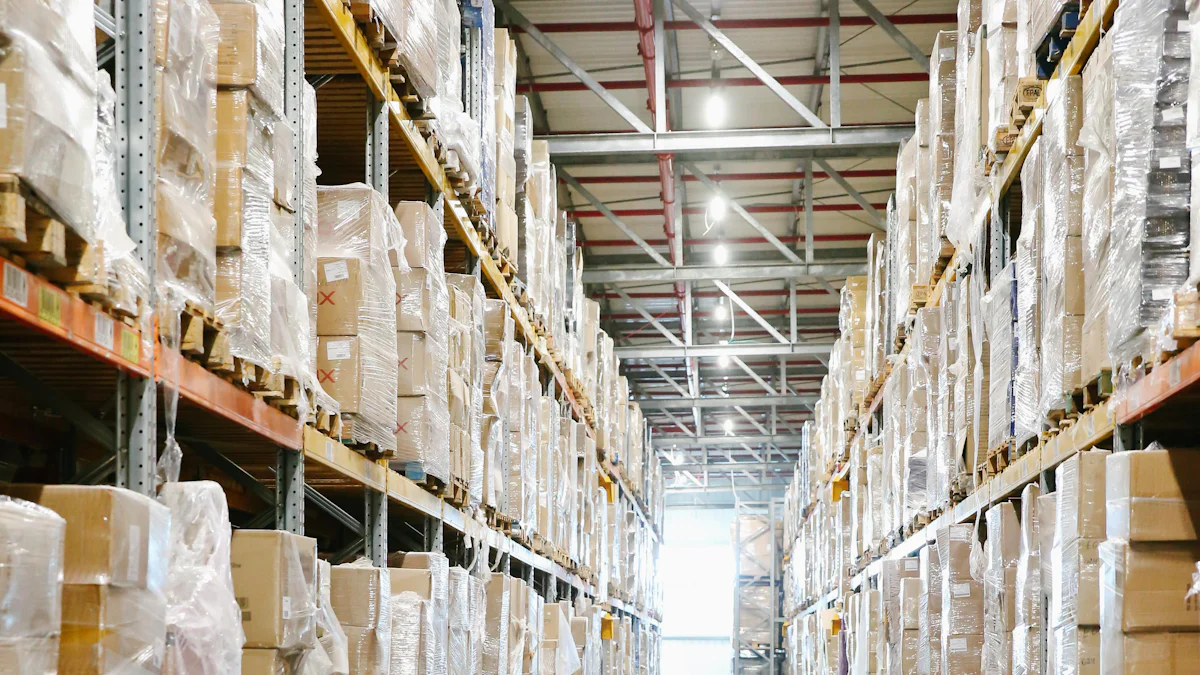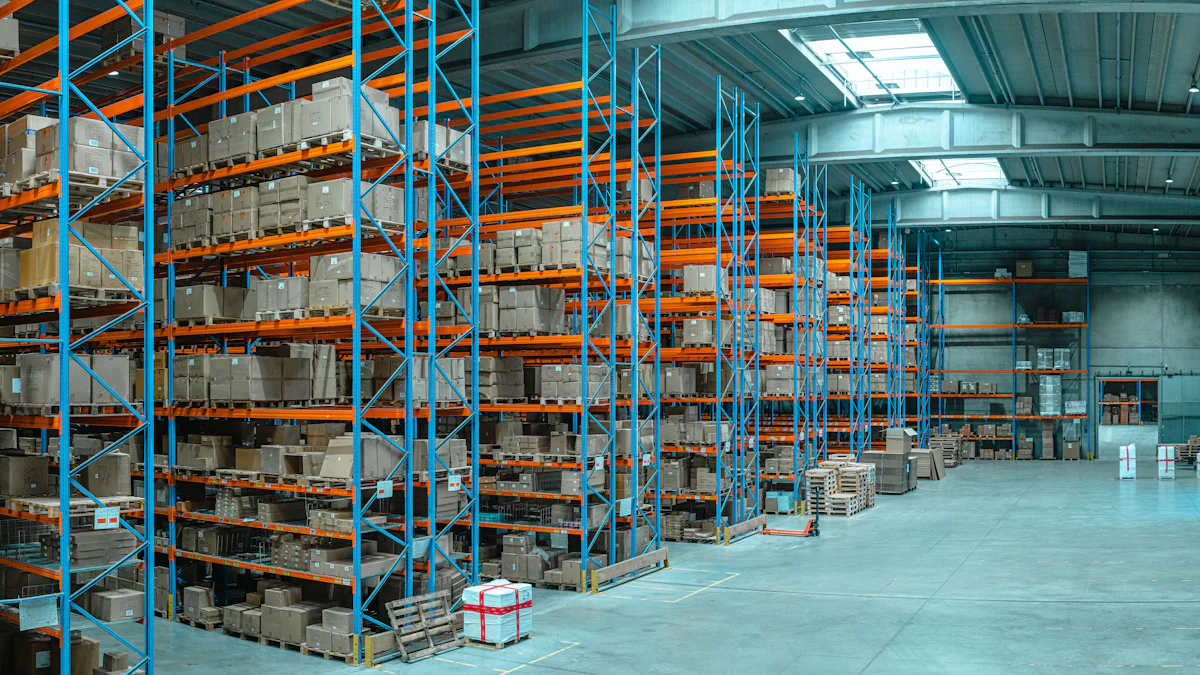Managing Supply Chain Risks When Ordering Flashlights in Bulk

When ordering flashlights in bulk, managing supply chain risks becomes essential for your business. Delays, quality issues, or unreliable suppliers can disrupt operations and harm customer trust. Batteries, a critical component of flashlights, add another layer of complexity. Poor storage or sourcing practices can lead to defective products. By addressing these risks, you ensure smooth operations and satisfied customers. A proactive approach to managing supply chain risks when ordering flashlights in bulk safeguards your business from unexpected disruptions.
Key Takeaways
Find main supply chain risks like late deliveries or bad suppliers.
Keep extra stock to avoid running out and meet customer needs.
Check suppliers carefully to make sure they are reliable and good.
Use live tracking systems to manage stock and improve shipping.
Review risks often and make backup plans for possible problems.
Identifying Key Supply Chain Risks

Delays in Delivery
Causes and impact of shipping and production delays.
Delays in delivery can disrupt your operations and lead to customer dissatisfaction. These delays often stem from production bottlenecks, unforeseen logistics issues, or challenges in transporting batteries. For example, batteries require careful handling due to strict safety regulations, which can slow down shipping processes. Weather conditions, port congestion, or customs clearance can also contribute to delays.
When shipments arrive late, your business may face supply chain disruptions. This can result in missed deadlines, reduced productivity, and strained customer relationships. To minimize these risks, you need to work closely with suppliers and logistics providers to ensure timely deliveries.
Quality and Safety Concerns
Ensuring product quality and addressing safety issues.
Maintaining quality and safety standards is crucial when ordering flashlights in bulk. Poor-quality flashlights or defective batteries can lead to customer complaints and even safety hazards like fire risks. To ensure compliance with safety regulations, you should prioritize rigorous quality control processes. High-quality LED flashlights not only enhance customer satisfaction but also reduce the likelihood of returns or recalls.
Adhering to industry standards is essential. For instance:
Consistent quality ensures customer expectations are met.
Certifications like CE and UL guarantee safety and performance.
RoHS compliance ensures the absence of hazardous materials.
Supplier documentation proves adherence to these requirements.
By focusing on these measures, you can mitigate risks and maintain a reliable supply chain.
Inventory Shortages
Challenges of demand forecasting and stockouts.
Inventory shortages can halt operations and damage your reputation. Stockouts often occur due to inaccurate demand forecasting or unexpected disruptions in the supply chain. For businesses relying on flashlights, such as logistics or manufacturing sectors, having a steady inventory is critical. Bulk orders help you avoid these issues by ensuring you have enough stock to meet demand.
When stockouts happen, your business may experience operational delays and dissatisfied customers. This can lead to lost revenue and weakened trust. By maintaining adequate inventory levels, you can prevent these challenges and keep your operations running smoothly.
Supplier Reliability
Risks of unreliable suppliers and the need for vetting.
Unreliable suppliers can disrupt your supply chain and harm your business. When suppliers fail to meet expectations, you may face unexpected costs, delays, or even complete order failures. These risks can jeopardize your ability to deliver products on time and maintain customer trust.
Here are some common risks associated with unreliable flashlight suppliers:
Inadequate pricing terms may lead to sudden cost increases, causing financial strain.
Unclear buyer requirements can result in suppliers adding cost buffers, leading to overspending.
Dependence on third-party vendors increases the risk of losses if those vendors fail to deliver.
To avoid these issues, you need to carefully evaluate potential suppliers before entering into agreements. Vetting suppliers ensures they meet your quality, reliability, and pricing standards. This process helps you identify trustworthy partners who can support your business goals.
Best practices for vetting flashlight suppliers include using RFx essentials and clear selection criteria. Establishing service level agreements (SLAs) ensures both parties understand their responsibilities. You should also evaluate suppliers based on specific metrics, such as delivery performance and product quality. Setting benchmark KPIs allows you to monitor supplier performance and address issues proactively.
By prioritizing supplier reliability, you reduce the likelihood of disruptions and build a more resilient supply chain. Reliable suppliers help you maintain consistent operations, meet customer expectations, and achieve long-term success. Take the time to vet your suppliers thoroughly to safeguard your business from unnecessary risks.
Strategies for Managing Supply Chain Risks When Ordering Flashlights in Bulk
Building Resilient Supplier Relationships
Effective communication and collaboration with suppliers.
Strong supplier relationships form the backbone of a stable supply chain. You should prioritize open communication with your suppliers to ensure they understand your requirements clearly. Regular updates about production schedules, logistics timelines, and compliance assurance help prevent misunderstandings. For example, discussing fire safety protocols for batteries during storage and transportation ensures adherence to regulations and reduces risks.
Collaboration also plays a vital role. By working closely with suppliers, you can address potential issues before they escalate. Joint planning sessions allow you to align on inventory needs, logistics schedules, and quality standards. Building trust with your suppliers fosters a partnership where both parties work toward shared goals, ultimately helping you mitigate supply chain risk effectively.
Maintaining Safety Stock and Buffer Inventory
Balancing inventory costs with risk mitigation.
Safety stock and buffer inventory act as essential safeguards against supply chain disruptions. Maintaining extra stock ensures you can meet customer demand even during unexpected events. This strategy is particularly important for flashlights, where batteries are critical components.
Buffer inventory offers several benefits:
It prevents stockouts, avoiding lost sales and customer dissatisfaction.
It helps manage seasonal fluctuations and demand variability.
It allows adjustments based on historical data and market trends.
While maintaining safety stock involves additional costs, the benefits outweigh the risks. You can use demand forecasting tools to determine optimal inventory levels. This approach balances cost efficiency with the need to mitigate supply chain risks when ordering flashlights in bulk.
Diversifying Suppliers and Sourcing Locations
Reducing dependency on single suppliers or regions.
Relying on a single supplier or region increases vulnerability to disruptions. Diversifying your sourcing strategy reduces this dependency and strengthens your supply chain. For instance, sourcing batteries from multiple regions ensures a steady supply even if one location faces challenges like natural disasters or political instability.
This approach provides alternative suppliers, allowing you to maintain operations without interruptions. Diversification also enhances your ability to negotiate better terms and ensures compliance with regional regulations. By spreading your sourcing network, you create a more resilient supply chain capable of withstanding unforeseen risks.
Exploring Nearshoring or Reshoring Options
Benefits of sourcing closer to home for supply chain stability.
Nearshoring or reshoring offers significant advantages for stabilizing your supply chain. By relocating production closer to your primary markets, you reduce the risks associated with long-distance sourcing. This strategy strengthens your ability to respond to disruptions and ensures a steady flow of essential components like batteries.
Nearshoring diversifies your supply chain by spreading production across multiple regions. This reduces your reliance on a single location, which can be vulnerable to natural disasters or political instability. For example, sourcing batteries from nearby suppliers minimizes delays caused by international shipping or customs clearance. You gain more control over your supply chain and can adapt quickly to changes in demand.
Local suppliers also provide easier access to resources. When you source batteries closer to home, you can monitor quality more effectively. This ensures compliance with safety standards and reduces the risk of defective products. Additionally, shorter transportation routes lower the chances of damage during transit, especially for sensitive items like batteries.
Another benefit of nearshoring is faster response times. You can adjust production schedules or inventory levels based on market trends without waiting for overseas shipments. This flexibility helps you meet customer demands more efficiently. For instance, if demand for flashlights spikes during an emergency, local suppliers can deliver batteries and other components quickly.
Nearshoring also supports cost savings in the long run. While initial setup costs may seem high, reduced shipping expenses and fewer delays offset these investments. You also build stronger relationships with local suppliers, fostering collaboration and trust. This partnership ensures a reliable supply of batteries and other materials, even during unforeseen challenges.
By exploring nearshoring or reshoring options, you create a more resilient supply chain. This approach enhances your ability to deliver quality products on time, keeping your customers satisfied and your business competitive.
Inventory Management Techniques for Bulk Flashlight Orders

Prioritizing High-Demand SKUs
Focusing on top-selling products to optimize resources.
Focusing on high-demand SKUs allows you to optimize your inventory management. By identifying top-selling flashlights, you can allocate resources more effectively and reduce unnecessary stock. SKU optimization provides insights into product performance and revenue contribution. This approach helps you determine which products to prioritize based on profitability.
Here are some benefits of prioritizing high-demand SKUs:
It reduces inventory costs by up to 36%.
It enhances inventory accuracy, ensuring you stock the right products.
It improves inventory forecasts, helping you meet customer demand.
Retailers who implement SKU optimization often see a 2-4% increase in profits and sales. By focusing on your best-performing products, you can streamline your operations and maximize returns.
Implementing Inventory Tracking Systems
Real-time tracking tools for better inventory control.
Real-time inventory tracking systems are essential for managing bulk flashlight orders. These tools provide accurate data on stock levels, helping you avoid overstocking or stockouts. With real-time updates, you can monitor the movement of flashlights and batteries across your supply chain.
Inventory tracking systems also improve logistics efficiency. They allow you to track shipments, ensuring timely deliveries and compliance with warehouse handling requirements. For example, you can monitor the logistics of storing batteries to ensure proper battery storage and adherence to fire safety regulations.
By implementing these systems, you gain better control over your inventory. This reduces errors, enhances customer satisfaction, and ensures your supply chain operates smoothly.
Managing Battery Shelf Life
Ensuring batteries remain functional during storage.
Proper battery storage is critical for maintaining battery shelf life. Batteries can degrade over time, leading to reduced performance or safety risks. To ensure your batteries remain functional, follow these best practices:
Avoid extreme temperatures. Store batteries in a cool, dry place to prevent damage.
Keep them dry. Moisture can affect batteries and internal flashlight components.
Use a protective case. This shields batteries from physical damage and dust.
Additionally, choose the right batteries recommended by the manufacturer. Replace batteries regularly to prevent leakage and corrosion. If you won’t use flashlights for an extended period, remove the batteries to avoid damage. These steps help you maintain battery shelf life and ensure your flashlights perform reliably when needed.
By managing battery shelf life effectively, you reduce the risk of fire hazards and ensure compliance with safety requirements. This approach also minimizes waste and enhances the longevity of your inventory.
Continuous Risk Assessment and Contingency Planning
Conducting Regular Supply Chain Risk Assessments
Identifying and addressing emerging risks.
Regular risk assessments help you identify and address potential threats to your flashlight supply chain. These assessments ensure you stay ahead of issues like supply chain disruptions or compliance failures. Start by identifying risks specific to flashlights, such as delays in sourcing batteries or challenges in meeting fire safety standards. Use tools like Failure Modes and Effects Analysis (FMEA) to evaluate potential failures and their impact. Business Impact Analysis (BIA) can also provide deeper insights into critical vulnerabilities.
You should balance your risk appetite with the potential impact on operations. For example, ensuring access to essential supplies like batteries reduces the likelihood of disruptions. Conduct annual reviews to pinpoint weaknesses and adjust your strategies. Low-regret actions, such as maintaining a steady supply of batteries, can safeguard your operations against unexpected risks.
Developing and Testing Contingency Plans
Steps to prepare for and mitigate disruptions.
Effective contingency plans prepare you for disruptions in your flashlight supply chain. Start by developing a dynamic playbook that incorporates lessons learned from past challenges. This playbook should embed risk and resilience across all functions. Establish crisis response resources, including simulations and scenario planning, to test your preparedness.
Supply chain control towers provide real-time visibility into logistics, helping you respond quickly to disruptions. For instance, if a shipment of batteries faces delays, control towers allow you to reroute or expedite alternatives. Continuous global risk monitoring ensures you stay informed about potential threats, such as regulatory changes or natural disasters. These steps help you mitigate risks and maintain smooth operations.
Monitoring Market Trends and Adapting Strategies
Staying informed to adjust procurement approaches.
Staying updated on market trends allows you to adapt your procurement strategies effectively. The flashlight market is shifting toward rechargeable models, which reduce waste and enhance convenience. Smart features like Bluetooth connectivity are also gaining popularity, enabling users to control settings via smartphone apps. Sustainability is another growing trend, with brands using recycled materials in production.
To align with these trends, focus on market segmentation to tailor your offerings to specific consumer needs. Understanding regional dynamics helps you adapt procurement strategies to local conditions. Strengthen supplier relationships to enhance efficiency and responsiveness. Consider technological advancements and sustainability priorities to meet evolving customer preferences. By monitoring trends, you can stay competitive and ensure your supply chain remains resilient.
Managing supply chain risks when ordering flashlights in bulk requires a proactive approach. You must address key risks like delivery delays, unreliable suppliers, and inventory shortages. Prioritize strategies such as supplier diversification, maintaining safety stock, and monitoring battery shelf life. Batteries play a critical role in ensuring product quality and customer satisfaction. Regular risk assessments and contingency plans help you stay prepared for disruptions. By implementing these strategies, you build a resilient supply chain that ensures smooth operations and reliable deliveries. Take action today to safeguard your business and meet customer expectations.
FAQ
What are the most common supply chain risks when ordering flashlights in bulk?
The most common risks include delivery delays, poor product quality, inventory shortages, and unreliable suppliers. These issues can disrupt your operations and harm customer satisfaction. Identifying these risks early helps you take proactive steps to mitigate them and maintain a stable supply chain.
How can you ensure the quality of flashlights ordered in bulk?
You can ensure quality by working with vetted suppliers, requesting product certifications like CE or UL, and conducting regular quality checks. Prioritize suppliers who provide documentation proving compliance with safety standards. This approach reduces the risk of defective products and ensures customer satisfaction.
Why is maintaining safety stock important for flashlight orders?
Safety stock acts as a buffer against unexpected supply chain disruptions. It ensures you can meet customer demand even during delays or shortages. While it adds inventory costs, it prevents stockouts, lost sales, and dissatisfied customers, making it a critical risk management strategy.
How do you manage battery shelf life for bulk flashlight orders?
Store batteries in a cool, dry place to prevent damage. Avoid extreme temperatures and moisture. Use protective cases to shield batteries from physical harm. Replace old batteries regularly to avoid leakage or corrosion. These practices ensure batteries remain functional and safe during storage.
What are the benefits of diversifying suppliers for flashlight components?
Diversifying suppliers reduces dependency on a single source, minimizing risks from regional disruptions like natural disasters or political instability. It ensures a steady supply of components, improves negotiation power, and enhances supply chain resilience. This strategy helps you maintain consistent operations and meet customer expectations.
See Also
Boosting Revenue By Sourcing Flashlights From Wholesalers
Maintain Quality Standards When Buying Flashlights Wholesale
Selecting Ideal LED Flashlights For Bulk Buying
